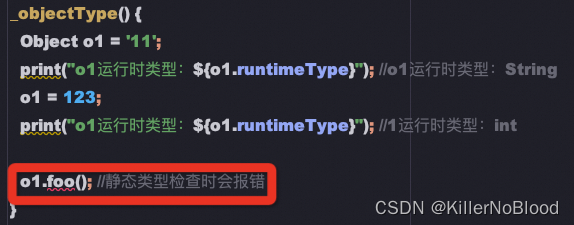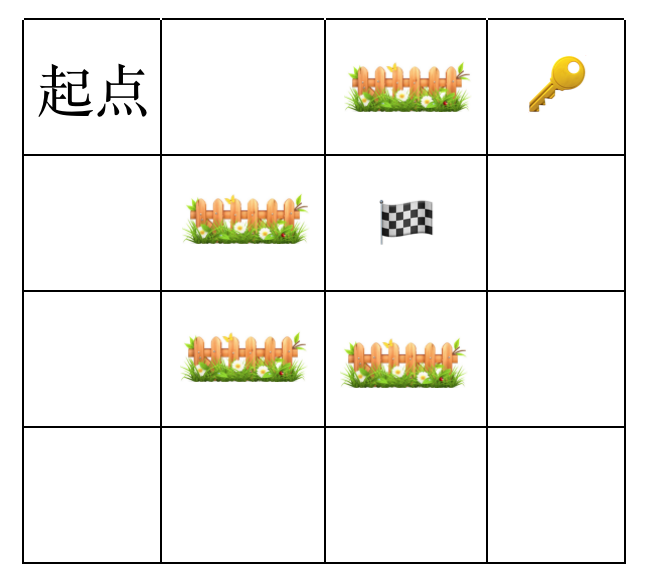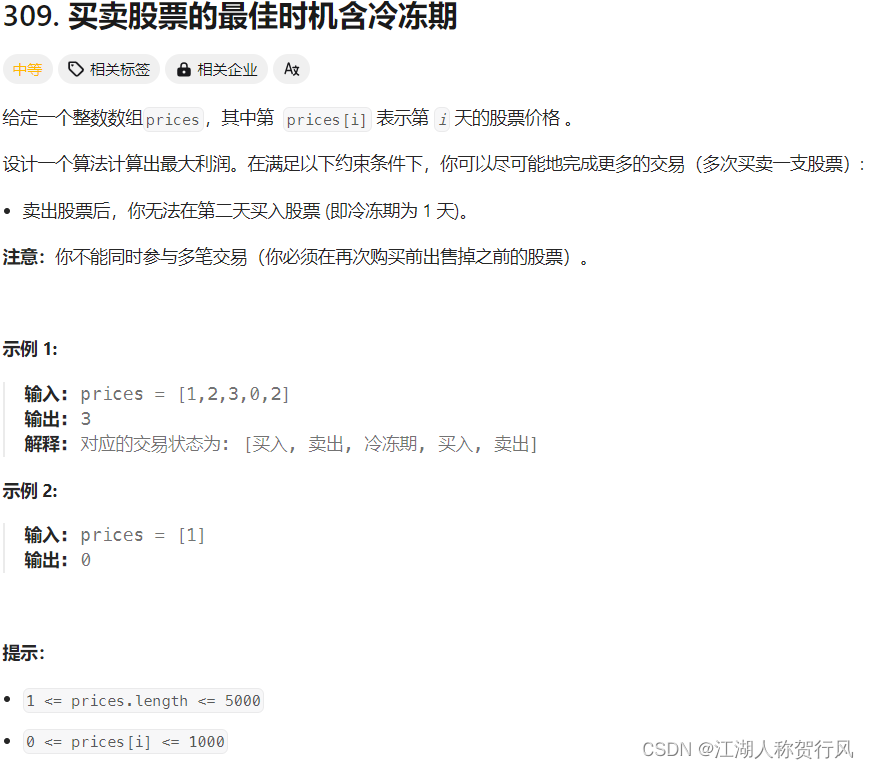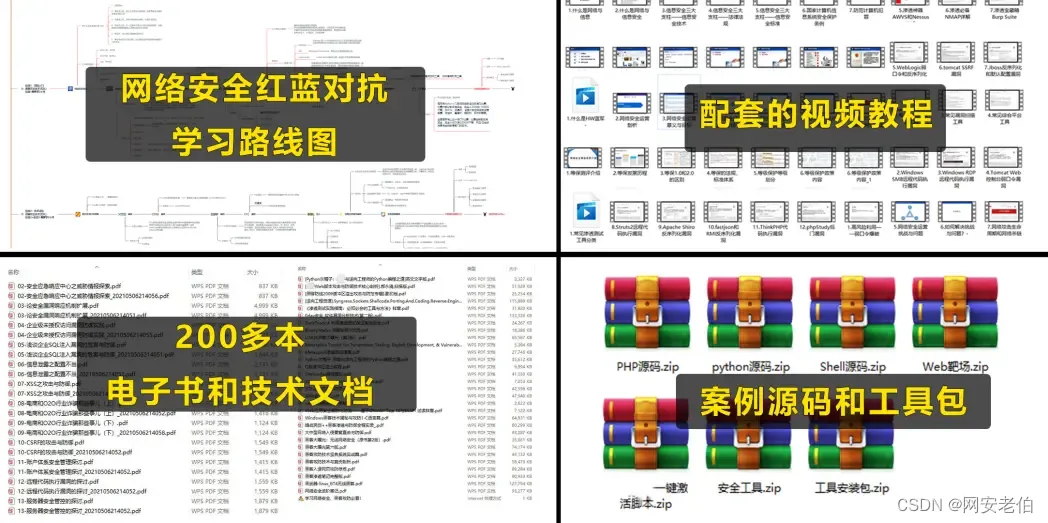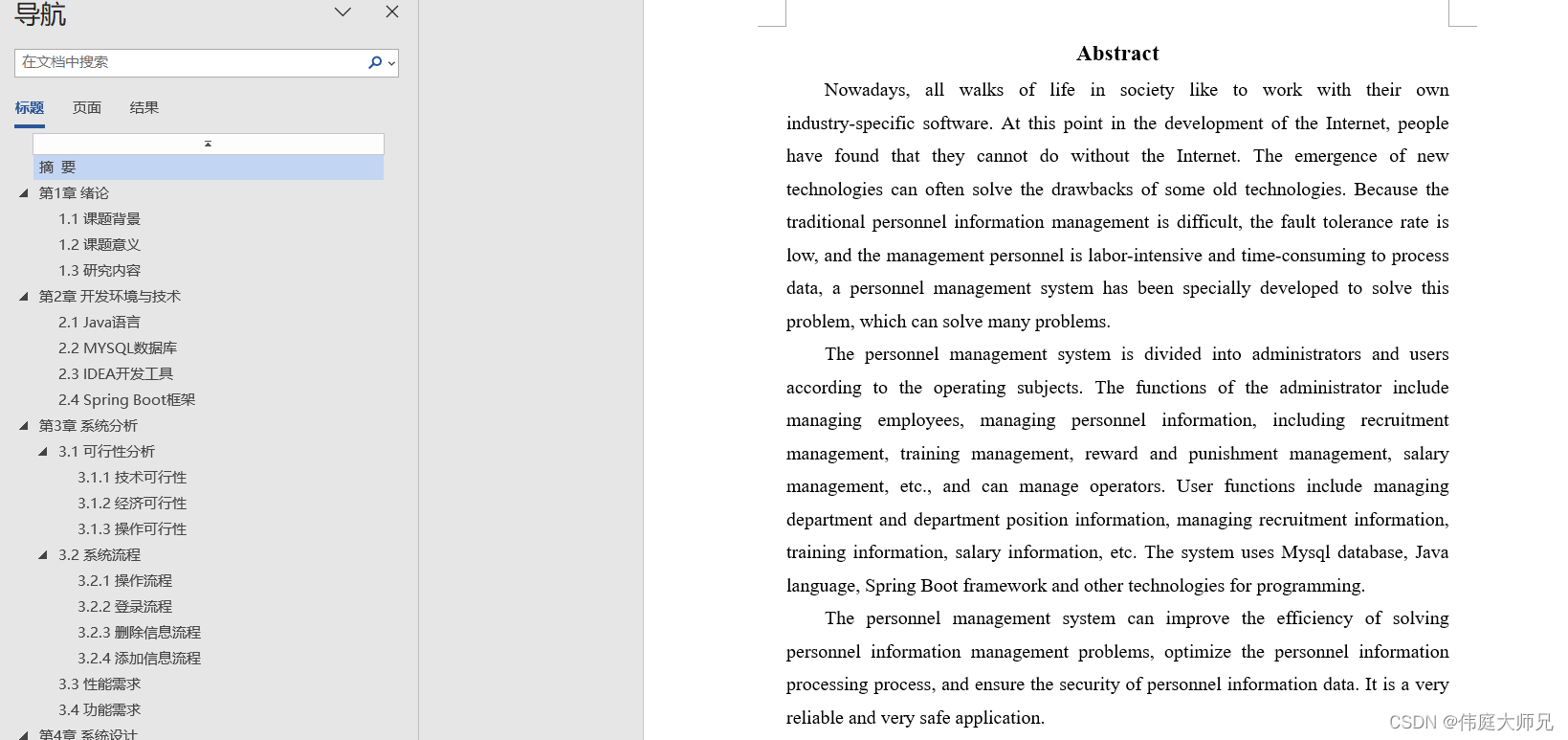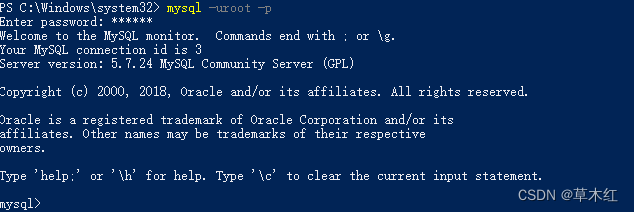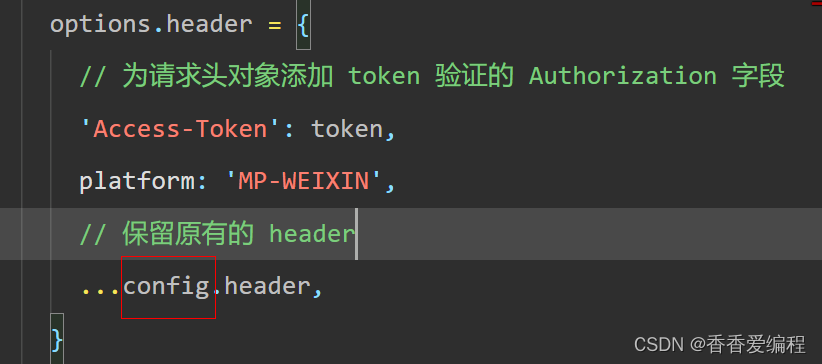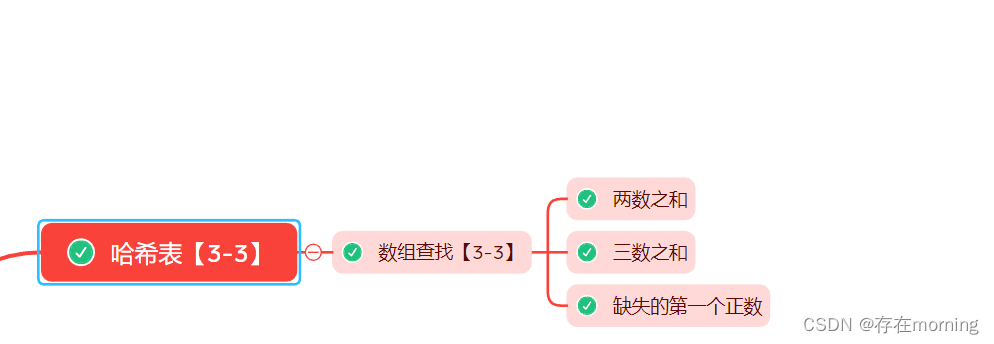写在前面:
- 本系列专栏主要介绍C++的相关知识,思路以下面的参考链接教程为主,大部分笔记也出自该教程,笔者的原创部分主要在示例代码的注释部分。
- 除了参考下面的链接教程以外,笔者还参考了其它的一些C++教材(比如计算机二级教材和C语言教材),笔者认为重要的部分大多都会用粗体标注(未被标注出的部分可能全是重点,可根据相关部分的示例代码量和注释量判断,或者根据实际经验判断)。
- 如有错漏欢迎指出。
参考教程:黑马程序员匠心之作|C++教程从0到1入门编程,学习编程不再难_哔哩哔哩_bilibili
七、list容器
1、list的基本概念
(1)list的功能是将数据进行链式存储,对应数据结构中的链表,链表是一种物理存储单元上非连续的存储结构,数据元素的逻辑顺序是通过链表中的指针链接实现的。
(2)链表由一系列结点组成,结点用结构体实现,其中的成员一个是存储数据元素的数据域,另一个是存储下一个结点地址的指针域。
(3)STL中的链表是一个双向循环链表。
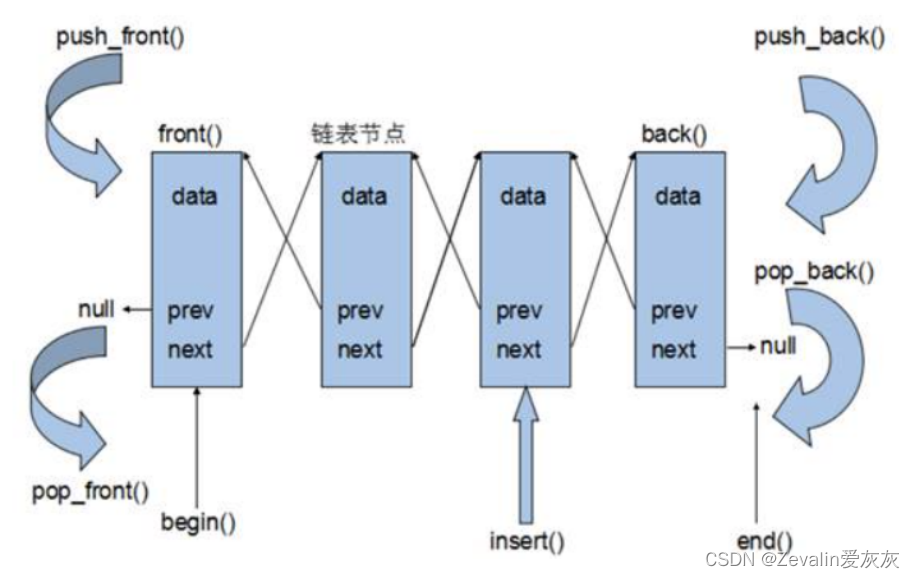
(4)由于链表的存储方式并不是连续的内存空间,因此链表中的迭代器只支持前移和后移,属于双向迭代器。
(5)list的优缺点:
①list的优点:采用动态存储分配,不会造成内存浪费和溢出;链表执行插入和删除操作十分方便,修改指针即可,不需要移动大量元素。
②list的缺点:链表灵活,但是空间(指针域)和时间(遍历)额外耗费较大;list有一个重要的性质,插入操作和删除操作都不会造成原有list迭代器的失效,这在vector是不成立的
2、list的构造函数
list<T> lst; //list采用采用模板类实现,对象的默认构造形式
list(beg,end); //构造函数将[beg, end)区间中的元素拷贝给本身
list(n,elem); //构造函数将n个elem拷贝给本身
list(const list &lst); //拷贝构造函数
#include<iostream>
#include<list>
using namespace std;
void printList(const list<int> &L)
{
for (list<int>::const_iterator it = L.begin(); it != L.end(); it++)
{
cout << *it << " ";
}
cout << endl;
}
void test01()
{
list<int>L1; //创建list容器
L1.push_back(10); //添加数据
L1.push_back(20);
L1.push_back(30);
L1.push_back(40);
printList(L1); //遍历容器
list<int>L2(L1.begin(), L1.end()); //区间方式构造
printList(L2);
list<int>L3(L2); //拷贝构造
printList(L3);
list<int>L4(4, 3000); //n个elem方式构造
printList(L4);
}
int main() {
test01();
system("pause");
return 0;
}3、list的赋值和交换操作
assign(beg, end); //将[beg, end)区间中的数据拷贝赋值给本身
assign(n, elem); //将n个elem拷贝赋值给本身
list& operator=(const list &lst); //重载等号操作符
swap(lst); //将lst与本身的元素互换
#include<iostream>
#include<list>
using namespace std;
void printList(const list<int> &L)
{
for (list<int>::const_iterator it = L.begin(); it != L.end(); it++)
{
cout << *it << " ";
}
cout << endl;
}
void test01()
{
list<int>L1;
L1.push_back(10);
L1.push_back(20);
L1.push_back(30);
L1.push_back(40);
printList(L1);
list<int>L2;
L2 = L1; //operator=赋值
printList(L2);
list<int>L3;
L3.assign(L2.begin(), L2.end()); //assign赋值
printList(L3);
list<int>L4;
L4.assign(10, 100); //n个elem赋值
printList(L4);
}
void test02()
{
list<int>L1;
L1.push_back(10);
L1.push_back(20);
L1.push_back(30);
L1.push_back(40);
cout << "交换前:" << endl;
printList(L1);
list<int>L2;
L2.assign(10, 100);
printList(L2);
cout << "交换后:" << endl;
L1.swap(L2);
printList(L1);
printList(L2);
}
int main() {
test01();
test02();
system("pause");
return 0;
}4、list的大小
size(); //返回容器中元素的个数
empty(); //判断容器是否为空
resize(num); //重新指定容器的长度为num,若容器变长,则以默认值填充新位置
//如果容器变短,则末尾超出容器长度的元素被删除
resize(num, elem); //重新指定容器的长度为num,若容器变长,则以elem值填充新位置
//如果容器变短,则末尾超出容器长度的元素被删除
#include<iostream>
#include<list>
using namespace std;
void printList(const list<int> &L)
{
for (list<int>::const_iterator it = L.begin(); it != L.end(); it++)
{
cout << *it << " ";
}
cout << endl;
}
void test01()
{
list<int>L1;
L1.push_back(10);
L1.push_back(20);
L1.push_back(30);
L1.push_back(40);
printList(L1);
if (L1.empty())
{
cout << "L1为空" << endl;
}
cout << "L1的元素个数(大小)为: " << L1.size() << endl;
L1.resize(8);
printList(L1);
L1.resize(3);
printList(L1);
L1.resize(10, 80);
printList(L1);
}
int main() {
test01();
system("pause");
return 0;
}5、list的插入和删除
push_back(elem); //在容器尾部加入一个元素
pop_back(); //删除容器中最后一个元素
push_front(elem); //在容器开头插入一个元素
pop_front(); //从容器开头移除第一个元素
insert(pos,elem); //在pos位置插elem元素的拷贝,返回新数据的位置
insert(pos,n,elem); //在pos位置插入n个elem数据,无返回值
insert(pos,beg,end); //在pos位置插入[beg,end)区间的数据,无返回值
clear(); //移除容器的所有数据
erase(beg,end); //删除[beg,end)区间的数据,返回下一个数据的位置
erase(pos); //删除pos位置的数据,返回下一个数据的位置
remove(elem); //删除容器中所有与elem值匹配的元素
#include<iostream>
#include<list>
using namespace std;
void printList(const list<int> &L)
{
for (list<int>::const_iterator it = L.begin(); it != L.end(); it++)
{
cout << *it << " ";
}
cout << endl;
}
//插入和删除
void test01()
{
list<int> L;
//尾插
L.push_back(10);
L.push_back(20);
L.push_back(30);
//头插
L.push_front(100);
L.push_front(200);
L.push_front(300);
printList(L);
//尾删
L.pop_back();
printList(L);
//头删
L.pop_front();
printList(L);
//插入
list<int>::iterator it = L.begin();
L.insert(++it, 1000);
printList(L);
//删除
it = L.begin();
L.erase(++it);
printList(L);
//移除
L.push_back(10000);
L.push_back(10000);
L.push_back(10000);
printList(L);
L.remove(10000);
printList(L);
//清空
L.clear();
printList(L);
}
int main() {
test01();
system("pause");
return 0;
}6、list的数据存取
front(); //返回第一个元素
back(); //返回最后一个元素
#include<iostream>
#include<list>
using namespace std;
void test01()
{
list<int> L;
L.push_back(10);
L.push_back(20);
L.push_back(30);
L.push_back(40);
cout << "第一个元素为:" << L.front() << endl;
cout << "最后一个元素为:" << L.back() << endl;
//cout << "第一个元素为:" << L[0] << endl; 不可以用[]访问list中的元素
//cout << "最后一个元素为:" << L.at(0) << endl; 不可以用at访问list中的元素
list<int>::iterator it = L.begin();
it++; //支持递增和递减(双向)
it--;
//it = it + 1; list本质是链表,不是用连续线性空间存储数据的,迭代器不支持随机访问
}
int main() {
test01();
system("pause");
return 0;
}7、list的反转和排序算法
reverse(); //反转链表(元素逆序存储)
sort(); //链表排序(给链表的元素排序)
#include<iostream>
#include<list>
#include<algorithm>
using namespace std;
void printList(const list<int> &L)
{
for (list<int>::const_iterator it = L.begin(); it != L.end(); it++)
{
cout << *it << " ";
}
cout << endl;
}
void test01()
{
list<int> L;
L.push_back(10);
L.push_back(50);
L.push_back(40);
L.push_back(30);
L.push_back(20);
printList(L);
L.reverse(); //反转
printList(L);
}
bool myCompare(int v1,int v2)
{
//降序--第一个数>第二个数
return v1 > v2;
//升序--第二个数<第一个数
}
void test02()
{
list<int> L;
L.push_back(10);
L.push_back(50);
L.push_back(40);
L.push_back(30);
L.push_back(20);
printList(L);
//sort(L.begin(), L.end()) 所有不支持随机访问迭代器的容器,都不可以用标准算法,但它们内部会提供对应的一些算法
L.sort(); //默认升序(从小到大)
printList(L);
L.sort(myCompare); //降序
printList(L);
}
int main() {
test01();
test02();
system("pause");
return 0;
}8、案例
(1)案例描述:将Person自定义数据类型进行排序,Person中属性有姓名、年龄、身高,按照年龄进行升序排序,如果年龄相同,按照身高进行降序排序。
(2)代码:
#include<iostream>
#include<list>
#include<string>
using namespace std;
class Person
{
public:
string m_Name;
int m_Age;
int m_Height;
Person(string name, int age, int height)
{
this->m_Age = age;
this->m_Height = height;
this->m_Name = name;
}
};
void printList(const list<Person> &L)
{
for (list<Person>::const_iterator it = L.begin(); it != L.end(); it++)
{
cout << "姓名: " << (*it).m_Name << " 年龄: " << (*it).m_Age << " 身高: " << it->m_Height << endl;
}
cout << endl;
}
bool myCompare(Person &v1, Person &v2)
{
if (v1.m_Age != v2.m_Age)
{
return v1.m_Age < v2.m_Age;
}
else
{
return v1.m_Height > v2.m_Height;
}
}
void test01()
{
list<Person>P;
Person p1("张三", 19, 173);
Person p2("李四", 34, 183);
Person p3("王五", 26, 163);
Person p4("刘六", 26, 170);
P.push_back(p1);
P.push_back(p2);
P.push_back(p3);
P.push_back(p4);
P.sort(myCompare);
printList(P);
}
int main() {
test01();
system("pause");
return 0;
}八、set/multiset容器
1、set/multiset的基本概念
(1)所有元素都会在插入set/multiset容器时自动被排序。
(2)set/multiset属于关联式容器,底层结构是用二叉树实现。
(3)set和multiset的区别:set不允许容器中有重复的元素,multiset允许容器中有重复的元素。
2、set构造函数和赋值操作
//构造函数:
set<T> st; //默认构造函数:
set(const set &st); //拷贝构造函数
//赋值操作:
set& operator=(const set &st); //重载等号操作符
#include<iostream>
#include<set>
using namespace std;
void printSet(set<int>&s)
{
for (set<int>::iterator it = s.begin(); it != s.end(); it++)
{
cout << *it << " ";
}
cout << endl;
}
void test01()
{
set<int>s1;
s1.insert(10); //只有insert能插入数据
s1.insert(20);
s1.insert(40);
s1.insert(30);
s1.insert(10);
printSet(s1); //插进set容器的数据会自动排序,且不会存在重复值
set<int>s2(s1); //拷贝构造
printSet(s2);
set<int>s3;
s3 = s2; //赋值
}
int main() {
test01();
system("pause");
return 0;
}3、set大小和交换操作
size(); //返回容器中元素的数目
empty(); //判断容器是否为空
swap(st); //交换两个集合容器
#include<iostream>
#include<set>
using namespace std;
void printSet(set<int>&s)
{
for (set<int>::iterator it = s.begin(); it != s.end(); it++)
{
cout << *it << " ";
}
cout << endl;
}
void test01()
{
set<int>s1;
s1.insert(10);
s1.insert(20);
s1.insert(40);
s1.insert(30);
printSet(s1);
if (s1.empty())
{
cout << "s1为空" << endl;
}
else
{
cout << "s1的大小为:" << s1.size() << endl;
}
}
void test02()
{
set<int>s1;
s1.insert(10);
s1.insert(20);
s1.insert(40);
s1.insert(30);
printSet(s1);
set<int>s2;
s2.insert(11);
s2.insert(21);
s2.insert(41);
s2.insert(31);
printSet(s2);
s1.swap(s2);
printSet(s1);
printSet(s2);
}
int main() {
test01();
test02();
system("pause");
return 0;
}4、set的插入和删除
insert(elem); //在容器中插入元素
clear(); //清除所有元素
erase(pos); //删除pos迭代器所指的元素,返回下一个元素的迭代器
erase(beg, end); //删除区间[beg,end)的所有元素 ,返回下一个元素的迭代器
erase(elem); //删除容器中值为elem的元素
#include<iostream>
#include<set>
using namespace std;
void printSet(set<int>&s)
{
for (set<int>::iterator it = s.begin(); it != s.end(); it++)
{
cout << *it << " ";
}
cout << endl;
}
void test01()
{
set<int> s1;
//插入
s1.insert(10);
s1.insert(30);
s1.insert(20);
s1.insert(40);
printSet(s1);
//删除
s1.erase(s1.begin());
printSet(s1);
s1.erase(30);
printSet(s1);
//清空
//s1.erase(s1.begin(), s1.end());
s1.clear();
printSet(s1);
}
int main() {
test01();
system("pause");
return 0;
}5、set查找和统计操作
find(key); //查找key是否存在,若存在,返回该键的元素的迭代器;若不存在,返回set.end();
count(key); //统计key的元素个数
#include<iostream>
#include<set>
using namespace std;
void printSet(set<int>&s)
{
for (set<int>::iterator it = s.begin(); it != s.end(); it++)
{
cout << *it << " ";
}
cout << endl;
}
void test01()
{
set<int> s1;
s1.insert(10);
s1.insert(30);
s1.insert(20);
s1.insert(40);
printSet(s1);
set<int>::iterator pos = s1.find(30);
if (pos != s1.end())
{
cout << "找到元素" << *pos << endl;
}
else
{
cout << "未找到元素" << endl;
}
pos = s1.find(50);
if (pos != s1.end())
{
cout << "找到元素" << *pos << endl;
}
else
{
cout << "未找到元素" << endl;
}
}
void test02()
{
set<int> s1;
s1.insert(10);
s1.insert(30);
s1.insert(30);
s1.insert(20);
s1.insert(40);
printSet(s1);
int num = s1.count(30);
cout << "“30”元素有" << num << "个" << endl; //结果要么是0,要么是1
num = s1.count(300);
cout << "“300”元素有" << num << "个" << endl;
}
int main() {
test01();
test02();
system("pause");
return 0;
}6、set和multiset的区别
(1)set不可以插入重复数据,而multiset可以。
(2)set插入数据的同时会返回插入结果,表示插入是否成功。
(3)multiset不会检测数据,因此可以插入重复数据。
#include<iostream>
#include<set>
using namespace std;
void printSet(set<int>&s)
{
for (set<int>::iterator it = s.begin(); it != s.end(); it++)
{
cout << *it << " ";
}
cout << endl;
}
void test01()
{
set<int> s1;
s1.insert(30);
s1.insert(30);
s1.insert(20);
s1.insert(40);
printSet(s1);
pair<set<int>::iterator, bool>ret = s1.insert(10);
if (ret.second)
{
cout << "第一次插入成功" << endl;
}
else
{
cout << "第一次插入失败" << endl;
}
printSet(s1);
ret = s1.insert(10);
if (ret.second)
{
cout << "第二次插入成功" << endl;
}
else
{
cout << "第二次插入失败" << endl;
}
printSet(s1);
multiset<int> ss1;
ss1.insert(30);
ss1.insert(30);
ss1.insert(20);
ss1.insert(40);
ss1.insert(30);
ss1.insert(30);
ss1.insert(20);
ss1.insert(40);
for (multiset<int>::iterator it = ss1.begin(); it != ss1.end(); it++)
{
cout << *it << " ";
}
cout << endl;
}
int main() {
test01();
system("pause");
return 0;
}7、set容器的排序规则
(1)set容器默认排序规则为从小到大,利用仿函数可以改变排序规则.
(2)举例:
①例1:
#include<iostream>
#include<set>
using namespace std;
class MyCompare
{
public:
bool operator()(int v1,int v2)
{
return v1 > v2;
}
};
void test01()
{
set<int>s1;
s1.insert(10);
s1.insert(30);
s1.insert(20);
s1.insert(40);
s1.insert(50);
for (set<int>::iterator it = s1.begin(); it != s1.end(); it++)
{
cout << *it << " ";
}
cout << endl;
set<int,MyCompare>s2; //指定排序规则为降序
s2.insert(10);
s2.insert(30);
s2.insert(20);
s2.insert(40);
s2.insert(50);
for (set<int,MyCompare>::iterator it = s2.begin(); it != s2.end(); it++)
{
cout << *it << " ";
}
cout << endl;
}
int main() {
test01();
system("pause");
return 0;
}②例2:
#include<iostream>
#include<set>
#include<string>
using namespace std;
class Person
{
public:
int m_Age;
string m_Name;
Person(int age,string name)
{
this->m_Age = age;
this->m_Name = name;
}
};
class MyCompare
{
public:
bool operator()(const Person &v1,const Person &v2)
{
return v1.m_Age > v2.m_Age;
}
};
void test01()
{
set<Person,MyCompare>p;
Person p1( 19 ,"张三");
Person p2( 34 ,"李四");
Person p3( 26 ,"王五");
Person p4( 28 ,"刘六");
p.insert(p1);
p.insert(p2);
p.insert(p3);
p.insert(p4);
for (set<Person, MyCompare>::iterator it = p.begin(); it != p.end(); it++)
{
cout << "姓名:" << it->m_Name << " 年龄:" << it->m_Age;
cout << endl;
}
}
int main() {
test01();
system("pause");
return 0;
}③例3:
#include<iostream>
#include<set>
#include<string>
using namespace std;
class Person
{
public:
int m_Age;
string m_Name;
Person(int age,string name)
{
this->m_Age = age;
this->m_Name = name;
}
};
class MyCompare
{
public:
bool operator()(const Person &v1,const Person &v2)
{
return v1.m_Age > v2.m_Age;
}
};
void test01()
{
multiset<Person,MyCompare>p;
Person p1( 19 ,"张三");
Person p2( 34 ,"李四");
Person p3( 26 ,"王五");
Person p4( 26 ,"刘六");
p.insert(p1);
p.insert(p2);
p.insert(p3);
p.insert(p4);
for (multiset<Person, MyCompare>::iterator it = p.begin(); it != p.end(); it++)
{
cout << "姓名:" << it->m_Name << " 年龄:" << it->m_Age;
cout << endl;
}
}
int main() {
test01();
system("pause");
return 0;
}九、map/multimap容器
1、map的基本概念
(1)map中所有元素都是pair,pair中第一个元素为key(键值),起到索引作用,第二个元素为value(实值)。
(2)map中的所有元素都会根据元素的键值自动排序。
(3)map/multimap属于关联式容器,底层结构是用二叉树实现。
(4)map的特点是可以根据key值快速找到value值。
(5)map和multimap的区别:map不允许容器中有重复key值的元素,multimap允许容器中有重复key值的元素。
2、pair对组创建
(1)成对出现的数据,利用对组可以返回两个数据。
(2)两个数据的数据类型可以不同。
//对组的定义
pair<type, type> p ( value1, value2 );
pair<type, type> p = make_pair( value1, value2 );
//访问对组的元素
p.first //第一个元素
p.second //第二个元素
#include<iostream>
#include<string>
using namespace std;
void test01()
{
pair<string, int>p("Tom", 20);
cout << "姓名: " << p.first << " 年龄:" << p.second << endl;
pair<string, int>p2 = make_pair("Jerry", 30);
cout << "姓名: " << p2.first << " 年龄:" << p2.second << endl;
}
int main() {
test01();
system("pause");
return 0;
}3、map的构造函数和赋值操作
//构造函数:
map<T1, T2> mp; //map默认构造函数
map(const map &mp); //拷贝构造函数
//赋值操作:
map& operator=(const map &mp); //重载等号操作符
#include<iostream>
#include<map>
using namespace std;
void printMap(map<int,int>&m)
{
for (map<int, int>::iterator it = m.begin(); it != m.end(); it++)
{
cout << "key = " << (*it).first << " value = " << it->second << endl;
}
cout << endl;
}
void test01()
{
map<int, int> m;
m.insert(pair<int, int>(1, 10));
m.insert(pair<int, int>(3, 20));
m.insert(pair<int, int>(2, 30));
m.insert(pair<int, int>(2, 30)); //key值重复,无法插入
m.insert(pair<int, int>(2, 20)); //key值重复,无法插入
m.insert(pair<int, int>(4, 40));
printMap(m);
map<int, int> m2(m);
printMap(m2);
map<int, int> m3;
m3 = m2;
printMap(m3);
}
int main() {
test01();
system("pause");
return 0;
}4、map的大小和交换操作
size(); //返回容器中元素的数目
empty(); //判断容器是否为空
swap(st); //交换两个集合容器
#include<iostream>
#include<map>
using namespace std;
void printMap(map<int,int>&m)
{
for (map<int, int>::iterator it = m.begin(); it != m.end(); it++)
{
cout << "key = " << (*it).first << " value = " << it->second << endl;
}
cout << endl;
}
void test01()
{
map<int, int> m;
m.insert(pair<int, int>(1, 10));
m.insert(pair<int, int>(3, 20));
m.insert(pair<int, int>(2, 30));
m.insert(pair<int, int>(4, 40));
if (m.empty())
{
cout << "map容器为空" << endl;
}
else
{
cout << "map容器的元素个数为:" << m.size() << endl;
}
}
void test02()
{
map<int, int> m;
m.insert(pair<int, int>(1, 10));
m.insert(pair<int, int>(3, 20));
m.insert(pair<int, int>(2, 30));
m.insert(pair<int, int>(4, 40));
printMap(m);
map<int, int> m2;
m2.insert(pair<int, int>(5, 100));
m2.insert(pair<int, int>(6, 200));
m2.insert(pair<int, int>(2, 300));
m2.insert(pair<int, int>(8, 400));
printMap(m2);
m.swap(m2);
printMap(m);
printMap(m2);
}
int main() {
test01();
test02();
system("pause");
return 0;
}5、map的插入和删除
insert(elem); //在容器中插入元素
clear(); //清除所有元素
erase(pos); //删除pos迭代器所指的元素,返回下一个元素的迭代器
erase(beg, end); //删除区间[beg, end)的所有元素 ,返回下一个元素的迭代器
erase(key); //删除容器中值为key的元素
#include<iostream>
#include<map>
using namespace std;
void printMap(map<int,int>&m)
{
for (map<int, int>::iterator it = m.begin(); it != m.end(); it++)
{
cout << "key = " << (*it).first << " value = " << it->second << endl;
}
cout << endl;
}
void test01()
{
map<int, int> m;
m.insert(pair<int, int>(1, 10)); //建议
m.insert(make_pair(2, 30)); //建议
m.insert(map<int, int>::value_type(3, 20)); //不建议
m[4] = 40; //不建议用于插入,不过[]可以用于访问value
printMap(m);
cout << m[5] << endl; //不存在key=5,直接输出0,顺便插入了pair<int, int>(5, 0)
cout << m[4] << endl;
printMap(m);
m.erase(--m.end());
printMap(m);
m.erase(2); //删除 key = 2 一组的数据
printMap(m);
//清空
//m.erase(m.begin(), m.end());
m.clear();
printMap(m);
}
int main() {
test01();
system("pause");
return 0;
}6、map查找和统计操作
find(key); //查找key是否存在,若存在则返回该键的元素的迭代器,若不存在则返回end()
count(key); //统计key的元素个数
#include<iostream>
#include<map>
using namespace std;
void test01()
{
map<int, int> m;
m.insert(pair<int, int>(1, 10));
m.insert(pair<int, int>(3, 20));
m.insert(pair<int, int>(3, 30));
m.insert(pair<int, int>(2, 30));
m.insert(pair<int, int>(4, 40));
map<int, int>::iterator pos = m.find(3);
if (pos != m.end())
{
cout << "查到了元素key = " << (*pos).first << " value = " << pos->second << endl;
}
else
{
cout << "未找到元素" << endl;
}
int num = m.count(3);
cout << "num = " << num << endl; //map不允许插入重复key元素,num要么为0,要么为1,不过multimap就不一定了
}
int main() {
test01();
system("pause");
return 0;
}7、map容器排序规则
(1)map容器默认排序规则为按照key值进行从小到大排序,利用仿函数可以改变排序规则。
(2)举例:
①例1:
#include<iostream>
#include<map>
using namespace std;
class MyCompare
{
public:
bool operator()(int v1,int v2)
{
return v1 > v2; //降序
}
};
void printMap(map<int, int, MyCompare>&m)
{
for (map<int, int, MyCompare>::iterator it = m.begin(); it != m.end(); it++)
{
cout << "key = " << (*it).first << " value = " << it->second << endl;
}
cout << endl;
}
void test01()
{
map<int, int,MyCompare> m;
m.insert(pair<int, int>(1, 10));
m.insert(pair<int, int>(3, 20));
m.insert(pair<int, int>(2, 30));
m.insert(pair<int, int>(4, 40));
m.insert(pair<int, int>(5, 50));
printMap(m);
}
int main() {
test01();
system("pause");
return 0;
}②例2:
#include<iostream>
#include<map>
#include<string>
using namespace std;
class Person
{
public:
int m_Age;
string m_Name;
Person(int age, string name)
{
this->m_Age = age;
this->m_Name = name;
}
};
class MyCompare
{
public:
bool operator()(const Person &p1, const Person &p2)
{
return p1.m_Age > p2.m_Age;
}
};
void test01()
{
map<Person, int, MyCompare>m;
Person p1(19, "张三");
Person p2(34, "李四");
Person p3(26, "王五");
Person p4(28, "刘六");
m.insert(make_pair(p1, 10));
m.insert(make_pair(p2, 20));
m.insert(make_pair(p3, 40));
m.insert(make_pair(p4, 30));
for (map < Person, int, MyCompare>::iterator it = m.begin(); it != m.end(); it++)
{
cout << "姓名: " << it->first.m_Name << " 年龄:" << it->first.m_Age << endl;
}
}
int main() {
test01();
system("pause");
return 0;
}十、终极案例
1、案例描述
(1)公司今天招聘了10个员工(ABCDEFGHIJ),10名员工进入公司之后,需要指派员工在哪个部门工作。
(2)员工信息有姓名和工资,部门分为策划、美术、研发三个部门。
(3)随机给10名员工分配部门和工资。
(4)通过multimap进行信息的插入key(部门编号)——value(员工)。
(5)分部门显示员工信息。
2、实现步骤
(1)创建10名员工,放到vector中。
(2)遍历vector容器,取出每个员工,进行随机分组。
(3)分组后,将员工部门编号作为key,具体员工作为value,放入到multimap容器中。
(4)分部门显示员工信息。
3、代码
#include<iostream>
#include<map>
#include<vector>
#include<string>
#include<time.h>
using namespace std;
class Worker
{
public:
string m_Name;
int m_Salary;
/*Worker()
{
m_Name = name;
m_Salary = Salary;
}*/
};
void createWorker(vector<Worker>&v)
{
string str = "ABCDEFGHIJ";
for (int i = 0; i < 10; i++)
{
Worker worker;
worker.m_Name = "员工";
worker.m_Name += str[i];
worker.m_Salary = rand() % 10000 + 10000;
v.push_back(worker);
}
}
void setGroup(multimap<string, Worker>&m , vector<Worker>&v)
{
vector<Worker>::iterator it = v.begin();
for (int i = 0; i < 10; i++)
{
int key = rand() % 3 + 1;
string bumen;
switch (key)
{
case 1:
bumen = "策划";
break;
case 2:
bumen = "美术";
break;
case 3:
bumen = "研发";
break;
default:
break;
}
m.insert(make_pair(bumen, *(it++)));
}
}
void showWorkerByGourp(multimap<string, Worker>&m)
{
multimap<string, Worker>::iterator it = m.begin();
cout << "策划部门:" << endl;
for (int i = 0 ; it != m.end() && i < m.count("策划"); it++ , i++)
{
cout << " 姓名:" << it->second.m_Name << " 工资:" << it->second.m_Salary << endl;
}
cout << "---------------------------" << endl;
cout << "美术部门:" << endl;
for (int i = 0; it != m.end() && i < m.count("美术"); it++, i++)
{
cout << " 姓名:" << it->second.m_Name << " 工资:" << it->second.m_Salary << endl;
}
cout << "---------------------------" << endl;
cout << "研发部门:" << endl;
for (int i = 0; it != m.end() && i < m.count("研发"); it++, i++)
{
cout << " 姓名:" << it->second.m_Name << " 工资:" << it->second.m_Salary << endl;
}
}
void test01()
{
vector<Worker>vWorker;
createWorker(vWorker);
/*for (vector<Worker>::iterator it = vWorker.begin(); it != vWorker.end(); it++)
{
cout << it->m_Name << " ";
}
cout << endl;*/
multimap<string, Worker>mGroup;
setGroup(mGroup, vWorker);
showWorkerByGourp(mGroup);
/*for (multimap<string, Worker>::iterator it = mGroup.begin(); it != mGroup.end(); it++)
{
cout << "部门:" << it->first << " 姓名:" << it->second.m_Name << " 工资:" << it->second.m_Salary << endl;
}*/
}
int main() {
srand((unsigned int)time(NULL));
test01();
system("pause");
return 0;
}

